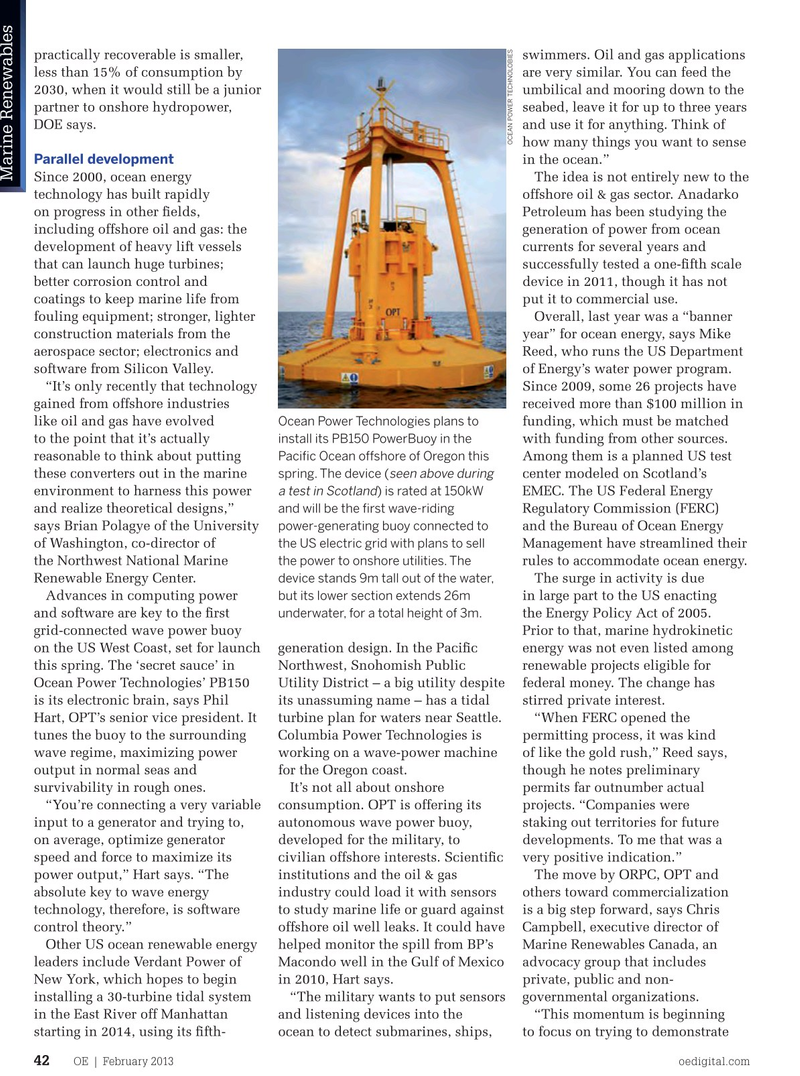
Page 40: of Offshore Engineer Magazine (Feb/Mar 2013)
Read this page in Pdf, Flash or Html5 edition of Feb/Mar 2013 Offshore Engineer Magazine
practically recoverable is smaller, swimmers. Oil and gas applications less than 15% of consumption by are very similar. You can feed the 2030, when it would still be a junior umbilical and mooring down to the partner to onshore hydropower, seabed, leave it for up to three years
DOE says. and use it for anything. Think of oceanpowertechnolobies how many things you want to sense
Parallel development in the ocean.”
Marine Renewables
Since 2000, ocean energy The idea is not entirely new to the technology has built rapidly offshore oil & gas sector. Anadarko on progress in other felds, Petroleum has been studying the including offshore oil and gas: the generation of power from ocean development of heavy lift vessels currents for several years and that can launch huge turbines; successfully tested a one-ffth scale better corrosion control and device in 2011, though it has not coatings to keep marine life from put it to commercial use.
fouling equipment; stronger, lighter Overall, last year was a “banner construction materials from the year” for ocean energy, says Mike aerospace sector; electronics and Reed, who runs the US Department software from Silicon Valley. of Energy’s water power program. “It’s only recently that technology Since 2009, some 26 projects have gained from offshore industries received more than $100 million in like oil and gas have evolved funding, which must be matched
Ocean Power Technologies plans to to the point that it’s actually with funding from other sources. install its PB150 PowerBuoy in the reasonable to think about putting Among them is a planned US test
Pacifc Ocean offshore of Oregon this these converters out in the marine center modeled on Scotland’s seen above during spring. The device ( environment to harness this power EMEC. The US Federal Energy ) is rated at 150kW a test in Scotland and realize theoretical designs,” Regulatory Commission (FERC) and will be the frst wave-riding says Brian Polagye of the University and the Bureau of Ocean Energy power-generating buoy connected to of Washington, co-director of Management have streamlined their the US electric grid with plans to sell the Northwest National Marine rules to accommodate ocean energy.
the power to onshore utilities. The
Renewable Energy Center. The surge in activity is due device stands 9m tall out of the water, Advances in computing power in large part to the US enacting but its lower section extends 26m and software are key to the frst the Energy Policy Act of 2005. underwater, for a total height of 3m. grid-connected wave power buoy Prior to that, marine hydrokinetic on the US West Coast, set for launch generation design. In the Pacifc energy was not even listed among this spring. The ‘secret sauce’ in Northwest, Snohomish Public renewable projects eligible for
Ocean Power Technologies’ PB150 Utility District – a big utility despite federal money. The change has is its electronic brain, says Phil its unassuming name – has a tidal stirred private interest.
Hart, OPT’s senior vice president. It turbine plan for waters near Seattle. “When FERC opened the tunes the buoy to the surrounding Columbia Power Technologies is permitting process, it was kind wave regime, maximizing power working on a wave-power machine of like the gold rush,” Reed says, output in normal seas and for the Oregon coast. though he notes preliminary survivability in rough ones. It’s not all about onshore permits far outnumber actual “You’re connecting a very variable consumption. OPT is offering its projects. “Companies were input to a generator and trying to, autonomous wave power buoy, staking out territories for future on average, optimize generator developed for the military, to developments. To me that was a speed and force to maximize its civilian offshore interests. Scientifc very positive indication.” power output,” Hart says. “The institutions and the oil & gas The move by ORPC, OPT and absolute key to wave energy industry could load it with sensors others toward commercialization technology, therefore, is software to study marine life or guard against is a big step forward, says Chris control theory.” offshore oil well leaks. It could have Campbell, executive director of Other US ocean renewable energy helped monitor the spill from BP’s Marine Renewables Canada, an leaders include Verdant Power of Macondo well in the Gulf of Mexico advocacy group that includes
New York, which hopes to begin in 2010, Hart says. private, public and non- installing a 30-turbine tidal system “The military wants to put sensors governmental organizations.
in the East River off Manhattan and listening devices into the “This momentum is beginning starting in 2014, using its ffth- ocean to detect submarines, ships, to focus on trying to demonstrate
OE | February 2013 oedigital.com 42 oe_renewables.indd 42 31/01/2013 10:44

 39
39

 41
41